The Meizu MX4 Pro Review
by Andrei Frumusanu on February 16, 2015 2:00 AM EST- Posted in
- Smartphones
- Exynos
- Mobile
- Meizu
CPU Performance
I've talked a bit about the Exynos 5430 in my Note 4 Exynos review where I revealed some benchmark numbers from the Galaxy Alpha. The 5430 is a 4xA7, 4xA15 octa-core SoC that is running big.LITTLE in heterogeneous multi-processing mode on top of a GTS ("Global Task Scheduling") software implementation.
In the Meizu MX4 Pro we see the A7 cores clocked at a higher 1.5GHz, with the A15 running at up to 2.0GHz. I noticed that the CPU isn't allowed to scale above 1.8GHz unless certain boost mechanisms are activated, such as switching apps. Since Meizu hasn't divulged the source code for the MX4 Pro, I can't be too sure how this mechanism works. The effect is that most benchmarks should actually have the CPU running at a 1.8GHz limit instead of 2.0GHz. Memory is limited to LPDDR3-1650 speeds, providing a theoretical 13.2GB/s bandwidth to the SoC.
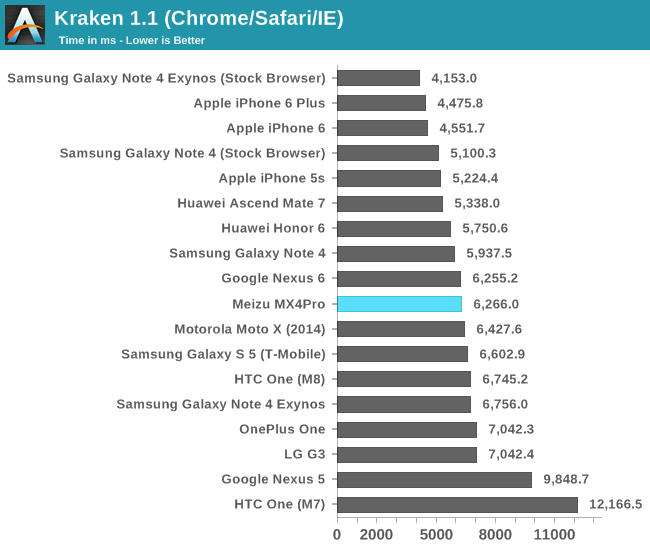
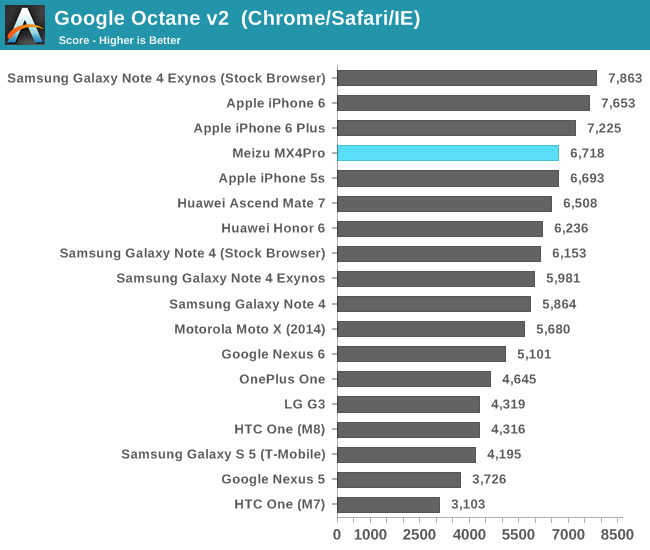
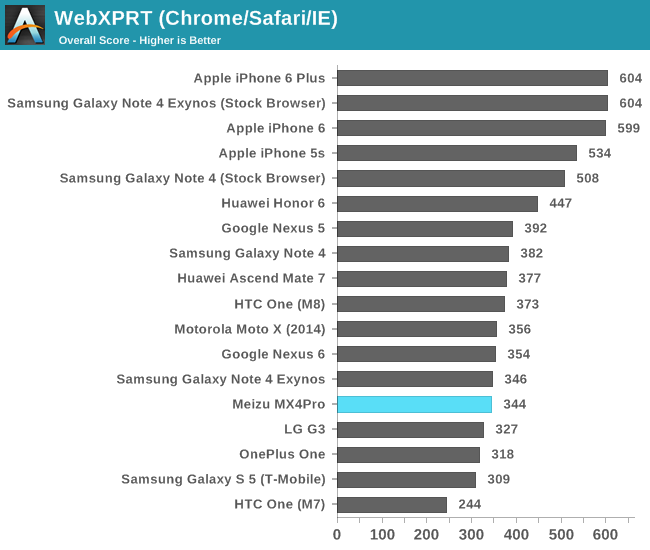
We've dropped SunSpider from our 2015 test suite as it was too sensitive as a micro-benchmark to browser optimizations and JavaScript engine compiler targets. Turning back to Kraken we see that the MX4 Pro doesn't perform that well, ending up in the middle of our latest flagship devices. The Alpha was able to achieve 4973ms on the same SoC, pointing to worse software optimization. Octane, being created by Google, achieves better scores in Chrome.
I've mentioned in the software section that the stock browser underperforms Chrome in the benchmarks. It's a pity because we've seen from the Exynos Note 4 review just how much performance can be squeezed out of the stock browser if properly optimized for the SoC-specific hardware. The 5430 should perform much better in native benchmarks.
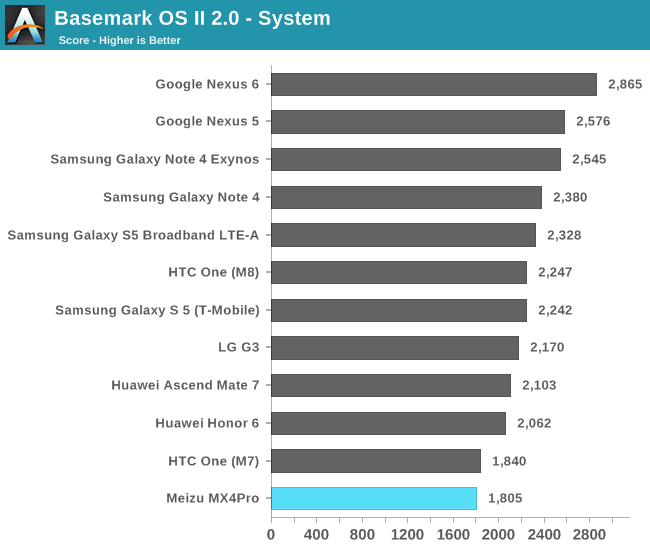
Starting with BaseMark OS II's system test, we see that the MX4 Pro scores quite low. The Galaxy Alpha with the same SoC scores 1958 points, about 10% higher. With both Lollipop Nexus devices topping this benchmark, it's clear that software optimizations bring lots of advantage to a device's ranking in this test.
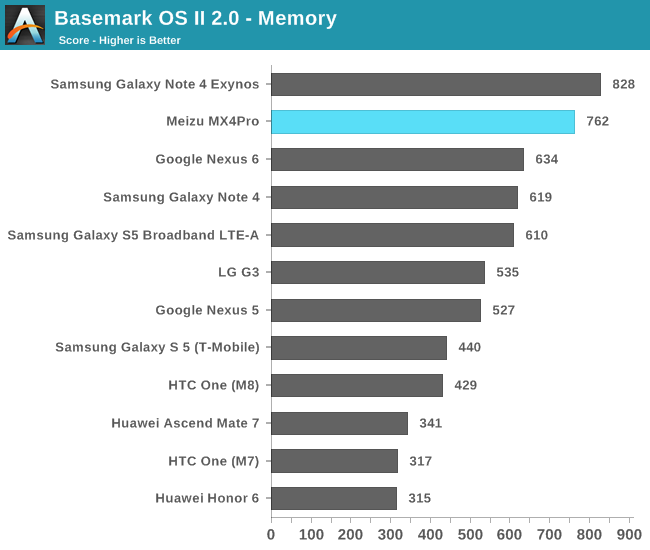
The Meizu performs excellently in the memory test, where the NAND is stressed and throughput is tested in collection of memory benchmarks. Although the Meizu does not possess the second-best eMMC module of the benchmarked phones, it looks again that Samsung's controller for some reason outperforms the competition by a sizeable margin.
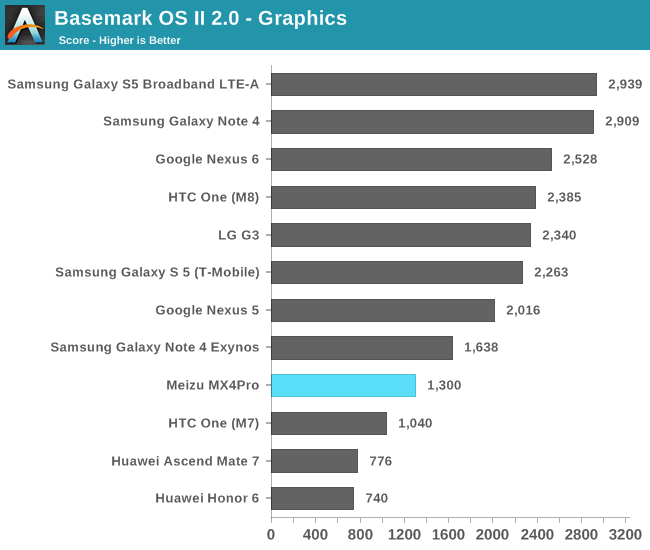
The Mali T628MP6 doesn't manage to keep up with the Qualcomm GPUs. We're again seeing it perform badly, consistent with the other Mali devices in this listing.
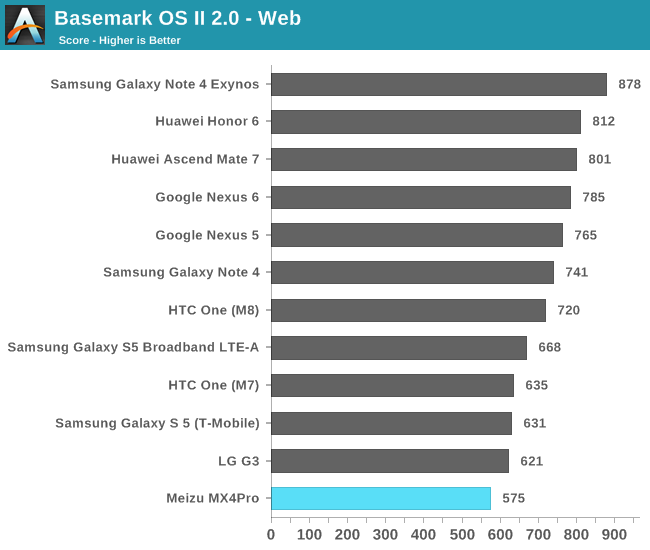
Lastly, the web test also puts the MX4 Pro last among the current generation flagships. The Alpha managed to achieve a score of 812 in this test. I may be repeating myself here but the reason is obvious: software, software, software.
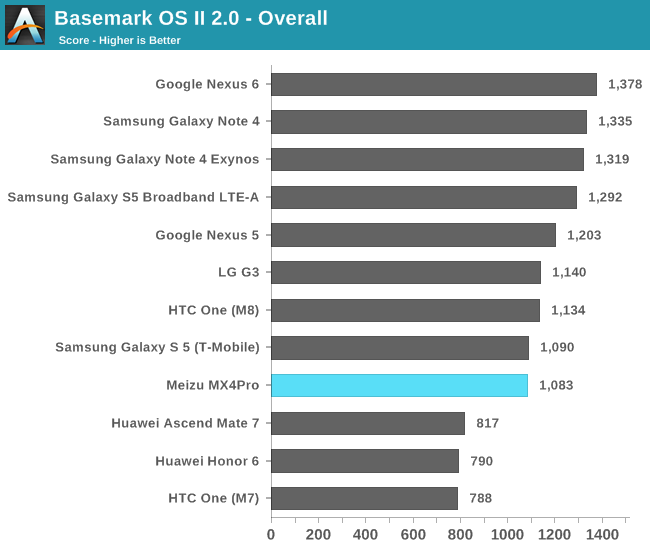
The overall BaseMark OS II score puts the MX4 Pro slightly under last generation's flagships such as the Galaxy S5, One M8, and the G3.
Moving over to PCMark, one of our newer additions to our mobile test suite, we're taking a look at real-world performance scenarios that one would encounter in daily apps and usage of a smartphone. These benchmarks are very OS sensitive and thus give a better impression of a device's real performance instead of synthetic CPU tests.
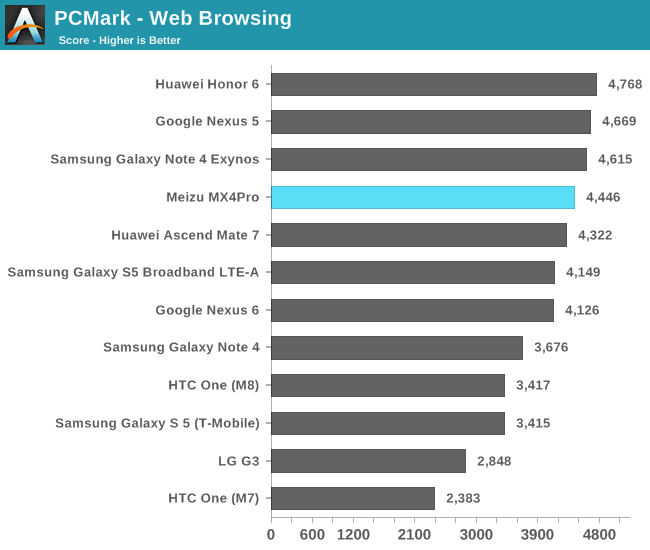
The web browsing test starts out as positive for the MX4 Pro, being able to reach the top performing group of devices on this benchmark. It's interesting to see how all ARM Cortex A15 and A57 devices are able to consistently outperform Qualcomm's Krait SoCs in this test.
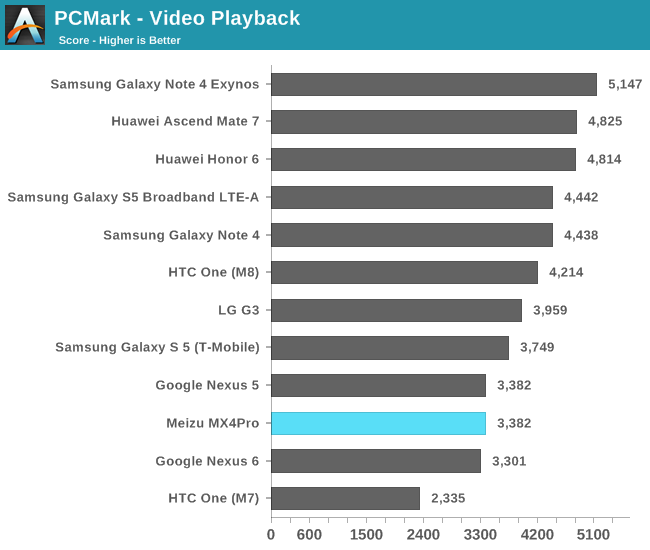
The video playback test uses the native Android MediaPlayer API to play back a 1080p H.264 baseline 4.0 video, with a variable target bit rate of 4.5Mbps at 30 FPS. What is measured here is the time needed to open the video samples, their average frame-rates, and the seek time when skipping through the videos.
The Meizu isn't performing too well in the video playback test. We saw how the Note 4 Exynos was able to outperform its Qualcomm counterpart with help of better eMMC controller performance and a good hardware decoder, but that doesn't seem to translate to the MX4 Pro in this test.
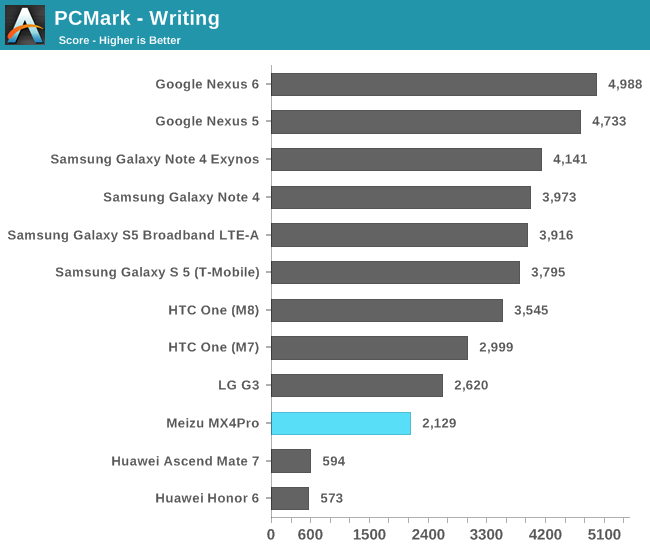
The writing test measures performance when manipulating a native EditText view. It loads, uncompresses, and pastes two documents together into what results in a 200k character piece of text. This is then compressed into a ZIP and saved. Further text manipulation is done and the API overhead and performance is measured.
It seems we're again hitting a software bottleneck here as the MX4 Pro behaves badly compared to our current flagship devices. Only Huawei's phones (which seem to be clearly broken in this benchmark) perform worse.
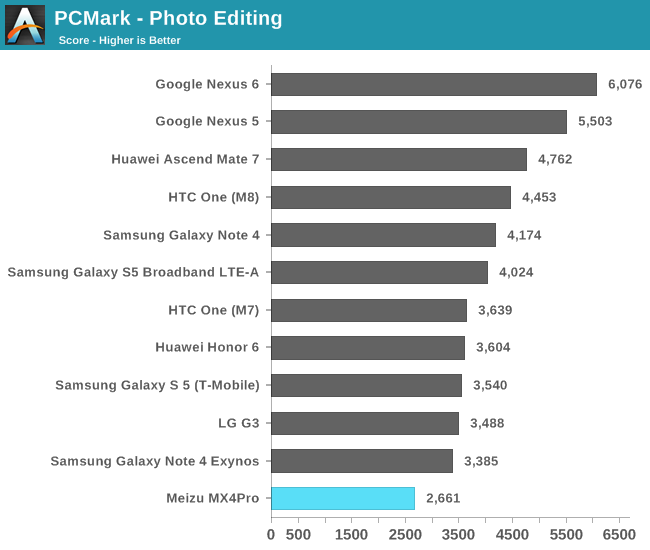
The photo editing test is a mix between API performance and both GPU and CPU performance. Image effects are applied via both the native effect API in Android, and also a RenderScript that tests heterogeneous processor performance (GPU and CPU). Additionally a Java library is used to test Java performance through processing filters that are computed on the CPU.
Here the MX4 Pro manages to come in last yet again. Did I mention software optimizations yet?
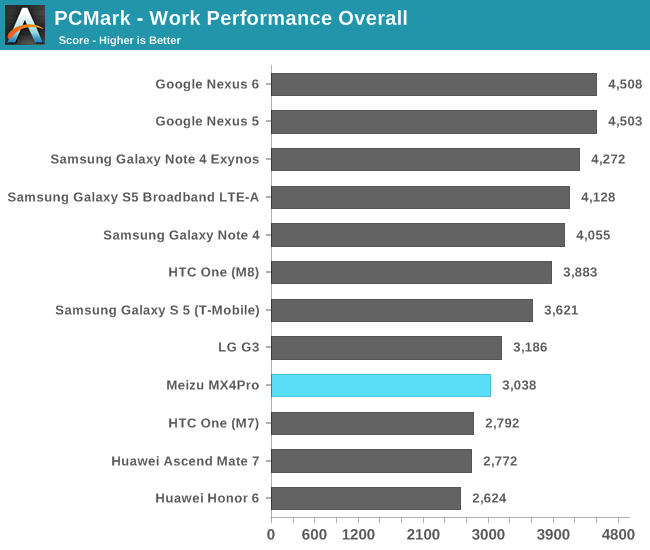
The overall work performance score puts the MX4 Pro just slightly higher than the Huawei counterparts that employ a similar SoC, and it's able to just outperform the last generation of SoC devices such as the Snapdragon 600 found in the One M7. What I've noticed while using the phone is that these numbers roughly correlate with what I've seen in real-world performance. Sometimes applications take a fraction of a second longer to open, or an app takes just a little bit longer to load a screen. I would be extremely curious how the MX4 Pro would perform on ART and Lollipop, because it's clear that there's a general lack of hardware optimizations on the stock ROM. Here's hoping that Meizu is listening and future software updates are able to improve performance.
NAND Performance
The Meizu MX4 Pro employs a SanDisk manufactured eMMC solution, the SDW32G with NAND storage manufactured by Toshiba. This should be an eMMC5.0 solution supporting HS200-DDR operation. Indeed when looking at the maximum sequential read and write scores in our AndroBench storage benchmarks, we see that the solution doesn't perform badly at all and is able to keep up with the current flagship generation, even outperforming some such as the Galaxy S5 or the One M8.
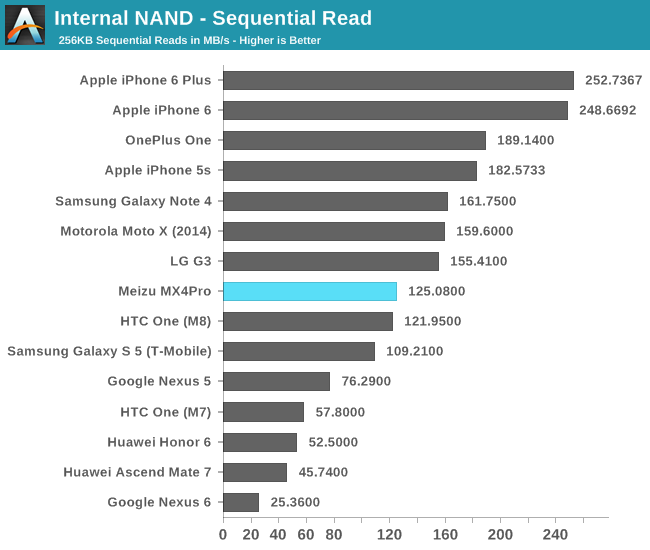
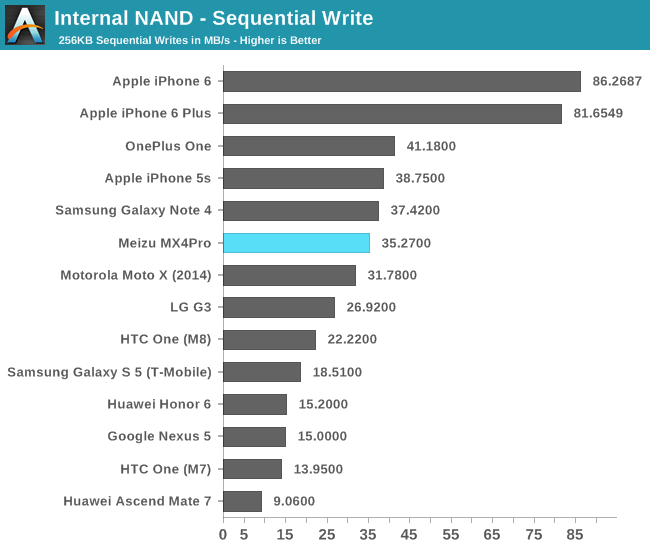
Switching over to the random read test, we see the MX4 Pro falling behind compared to the more expensive high-end competition.
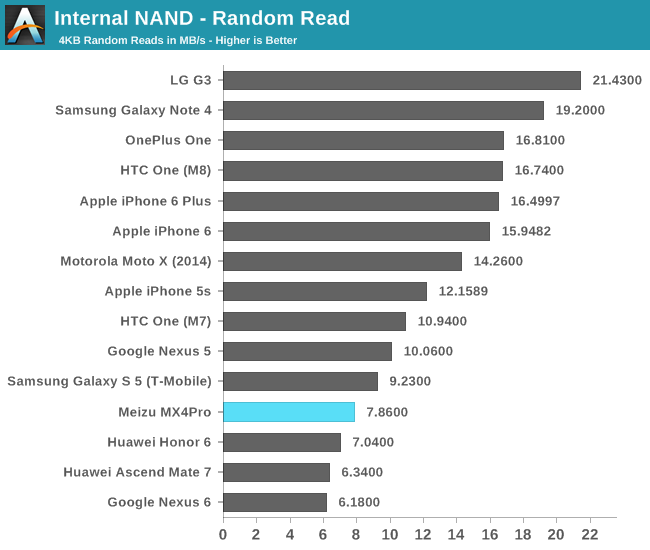
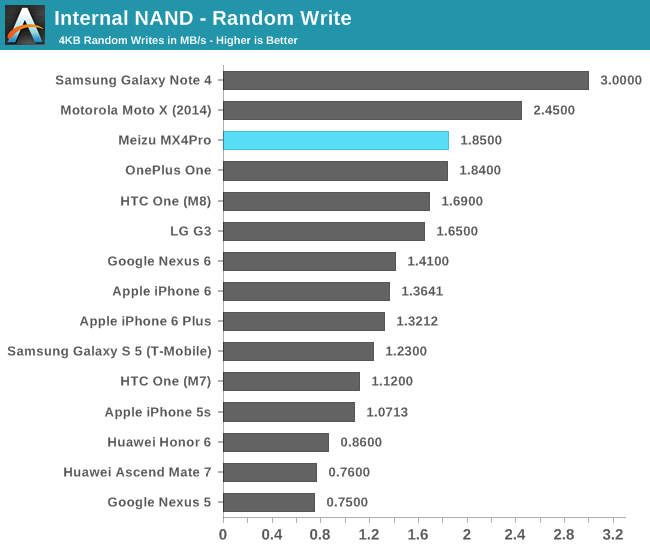
The random write test performs better for the SanDisk eMMC as it lands our 3rd best score. Overall I think Meizu employed a performant and competitive NAND solution on the MX4 Pro, a surprising conclusion given the bad experience we've had until now with Chinese phones and the poor showing of some other China-focused devices.










70 Comments
View All Comments
aryonoco - Monday, February 16, 2015 - link
As much as I appreciate your in-depth analysis of SoC, power usage and displays Andrei, your taste in UI really baffles me.That is the most hideous, disjointed, inexplicably redundant UI I have ever seen on an Android device, and you seem to like it. I'm simply astounded that you like this everything-and-the-kitchen-sink approach that many Chinese OEMs employ in regards to their ROMs. Brian and Anand knew that every additional UI feature comes with a cost, and it's a matter of finding the sweet spot. This point seems to be totally lost on you.
As an occasional Android developer, I would hate to think what Play Store reviews would look like if phones like this, with their ability to revoke permissions from apps and for users to break apps without realising that they have done so, would look like. Thankfully, no OEM which actually provides customer care support is going to implement this in a Western country, as the support cost is going to be enormous.
I really don't mean to sound disrespectful, but I'd love for Andrei to limit himself to hardware discussion in future Android devices (in which he is extremely skilled), and leave the UX review for someone with a bit more, shall I say, taste
Andrei Frumusanu - Monday, February 16, 2015 - link
I'm reviewing for the user, not for the OEM. In my opinion Android suffers a lot from Adware and misbehaving apps that such permission managers are a pure benefit to the user as already commented by some others here.I have experience in software UI design and user interaction, so while you might disagree with me I see plenty of other people who find Meizu's new UI equally attractive.
overseer - Monday, February 23, 2015 - link
To me Flyme OS has a homescreen with icons ugly as Quasimodo's face and so 2010, but the rest of interfaces (settings, notifications, etc) look strangely okay and taste somewhat close to Lollipop. This is a huge disparity in design practices and keeps me wondering if Meizu's UI designers hold a paranoiac love over that homescreen or they kind of hit a temporary ceilling in their professional competency. I would've taken the plunge for MX4 months ago had I not seen their everlasting homescreen. *_*samflorin - Tuesday, February 17, 2015 - link
@aryonoco cm11S for One+ called, would like a word on the built in permission manager.ffsmaster - Tuesday, February 17, 2015 - link
It is a pity that this review does not include the audio system: ES9018K2M+OPA1612.Andrei Frumusanu - Tuesday, February 17, 2015 - link
I just didn't have anything to write about it. It sounds good? Without proper equipment as in the iPhone 6 review audio testing has become futile.vanguardkl - Wednesday, September 28, 2016 - link
This. I'm coming back here in Sept 2016 just to say this. This phone is 1.5 years old - has a 2k screen. HD HiFi audio DAC - most people have to spend $100 just to buy this separately - among the best specs seen on any phone - and costs $150 now. I'm buying one as soon as I can - there's nothing that comes close to this value. This phone is a diamond in the rough, and once people know about its gonna be snapped up.. Hopefully this comment stays in the dirt. I have a Meizu M1 Note which I got for $125 and its next to perfect with 1080p screen and all. They provide MONTHLY updates to the OS and improvements all the time. Amazing I'm so happy with Meizu and hopefully they remain buried under the news headlines and I can pick up these phones for cheap.loimlo - Thursday, February 19, 2015 - link
Nice job! Well-written review!! How about other Chinese vendors like Xiaomi, Oppo, Vivo ?I've been using Redmi for a year and am very fond of it. Solid HW/SW given its humble pricing.
Hrushi - Thursday, August 6, 2015 - link
It is surprising to see that anandtech have missed on detailed audio quality analysis even when device have boasted this feature.inguru - Thursday, July 21, 2016 - link
Brother if you are really considering this to buy please be sure. Coz if something happens you cant fix this one. They have this digital security locked to its mainboard which you will not able to overwrite. No flashtool no ADB no fastboot what ever you try it will never be fixed & they are very dictating by saying send the phone to them but at the time you will b out of warranty and no place you will be able to go to bring it back. Its a dictatorship company. Be aware... you will never want to be in this situation